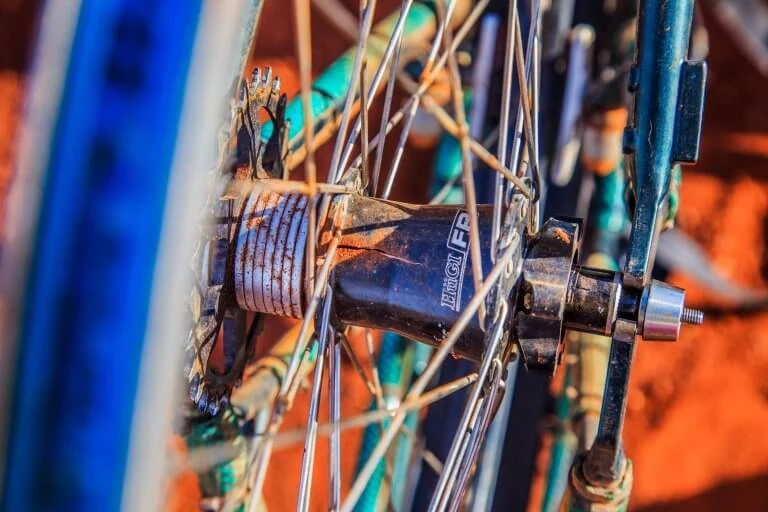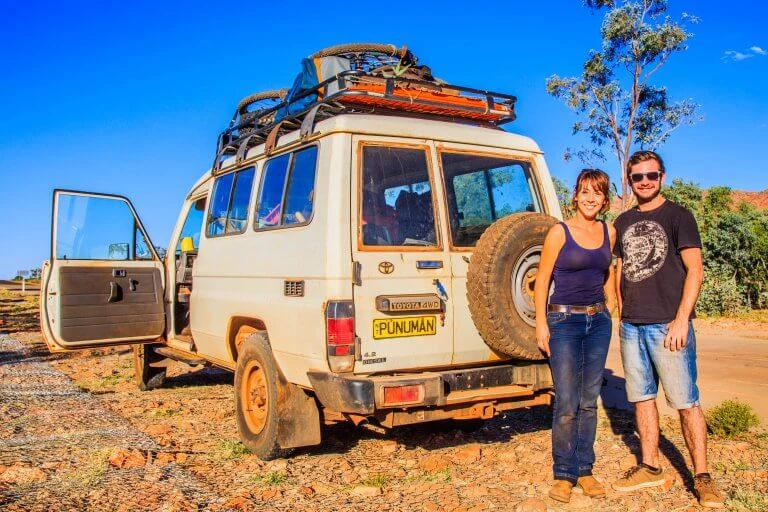In the outback
Thursday, May 24, 2018
- Three Continents
Back in Kalgoorlie I needed a few more days to buy groceries and prepare Dusty (my bike) for the outback. Heavy laden, I drove off after a week.
Soon I realized that my bike was completely overloaded. So after 50km I had to stop a car and ask if they could take some of my food to Laverton.
Between Kalgoorlie and Alice Springs (1'900km distance) there is hardly a real village and the few shops in the outback are very expensive. That's why I had to bring food for almost 30 days.
As far as Leonora I drove along the Goldfields Highway. Then I turned off in the direction of Laverton. Until this village, the road was still paved.
The Great Central Road begins a few miles to Laverton. The route crosses several Aboriginal areas and therefore you need two permits for the crossing.

I was able to apply for both permits at the Visitor Center in Laverton. You do not have to pay anything but the waiting period can take up to 5 days. Fortunately, the staff at the Visitor Center had good relationships and could speed up the process for me a little.
After a rest day in Laverton we finally went to Great Central Road. The Great Central Road is part of the Outback Highway, which runs 2800 km through the center of Australia and is also known as the longest shortcut (the longest shortcut).
The track crosses the outback from southwest to northeast between the Great Victoria Desert to the southeast and the Gibson Desert to the northwest.
The gravel road whirls up a lot of dust when vehicles drive by, but luckily the traffic here is pretty low. Although the corrugated tracks are not always easy to navigate with the bike I liked the area right away.
The seclusion and silence out here is just fantastic. Exactly what I have always missed so much in Asia and Africa. For me it is the most beautiful, where there are as few people as possible.
However, I also had to fight with a few real pests: the flies. At sunrise, the Mistviecher arrive in huge crowds and try to fly into every imaginable body opening until sunset.

The only help to not completely spin is a head net. When drinking and eating the thing bothers me a bit but I soon got used to it.
The biggest challenge for cyclists is the large distances between the individual roadhouses. A roadhouse in Australia is in the broadest sense a service area that includes a gas station and vehicle repair shop with attached restaurant.
Sometimes I had to carry over 30 liters of water, because there was more than 200km distance between the roadhouses and I managed on the gravel roads with strong headwind mostly only 50km a day.
I filled a big duffle bag with all food and substitute material, which I did not need urgently, and always gave this bag to a couple of drivers to transport to the next roadhouse. So I was able to save a lot of weight.
Every evening I pushed my bike somewhere in the bush, put up my tent, made a fire and enjoyed the atmosphere.

When I lay exhausted in the tent in the evening and looked at the huge starry sky while falling asleep, I felt overjoyed.
When I cycle I try whenever possible through deserts or high mountains to cycle. In each of these landscapes, I feel like a speck of dust in the universe. An almost indescribable feeling that you must have experienced yourself.
After 9 days I reached Warburton. Warburton is known for having Aboriginal painters there, and the resulting Warburton art project represents an opportunity for Aboriginal people to live their own culture and lifestyles through their own strength and without government help.
My plan was to have a rest day at the Roadhouse's campsite and then continue cycling the next day. However, I did not get very far when I left.
On the first climb to Warburton I heard a familiar noise on the rear wheel and knew immediately what the problem was: Speichenbruch.
Annoyed, I started to replace the spoke and discovered a crack in my rear hub. At that moment, I could understand how a knockout must feel when boxing.

I was immediately aware that this meant the end for me. The incident could not have happened in any other place. Frustrated, I pushed my bike back to the Roadhouse.
The owners there were extremely friendly and provided me with a room for free until I found a solution. This was not easy.
The nearest bike shop is located in Alice Springs, 1'000km away, there is no public transport in the area, airplanes can not bring bicycles and most of the vehicles here are chronically overloaded.
To deliver a spare part to this remote area would have taken about 2 weeks and cost a lot of money. Something of which I do not have much left after 3 years of traveling.
I had to wait 5 days until I finally found a transport. Amelie and her partner work for the Maruku Art Gallery, which collects woodcarvings from individual Aboriginal communities and sells them to tourists in Uluru and Yulara maruku.com.au.

On the one hand, they enable the Aborigines to maintain their tradition while securing a small income. I was allowed to load my bike on the roof and accompany her for a day.
The two took me to Yulara at Ayers Rock. There I had to search another 4 days and wait until finally someone took me to Alice Springs.
Siegfried is originally from Germany, but has been living in Australia for a long time. At the moment he is traveling through this huge country with his Mercedes Sprinter and still has some space in his bus for me.
We made a detour to walk through the Olgas. The Kata Tjuṯa (the Olgas) are a group of 36 mountains. The Kata Tjuta originated about 550 million years ago at the same time with the Uluru.
The Kata Tjuṯa are owned by the Anangu. Since, according to their mythology, the Kata Tjuṯa are associated with the Dreamtime, the Anangu use it as a place for rituals.
After saying goodbye to Siegfried in Alice Springs, I first had to put together a plan. The big question was how to go on?
I do not like the paved roads in Australia at all. These are just way too tight and most drivers have no idea how to overtake cyclists properly. That's why I try to avoid gravel roads as often as possible. There are plenty of them here.
However, I was aware after this experience with my hub, that I need a trailer on the one hand to relieve the rear wheel and on the other hand to be able to transport enough food and water.
Since my financial situation does not look very good and it would have been very expensive to fly home with my bike and all my luggage, I decided instead to store the bike and luggage here in Alice Springs, to fly back to Switzerland, a little money earn and come back to the Outback to Australia next year.
This was not an easy decision for me. I would have liked to continue cycling like Heinz pieces. There is nothing better for me. However, this is quite difficult without money.
So I soon had to say goodbye to Dusty with a heavy heart. Now it is unexpectedly home for a few months. I'm looking forward to getting back in the saddle as soon as possible ...